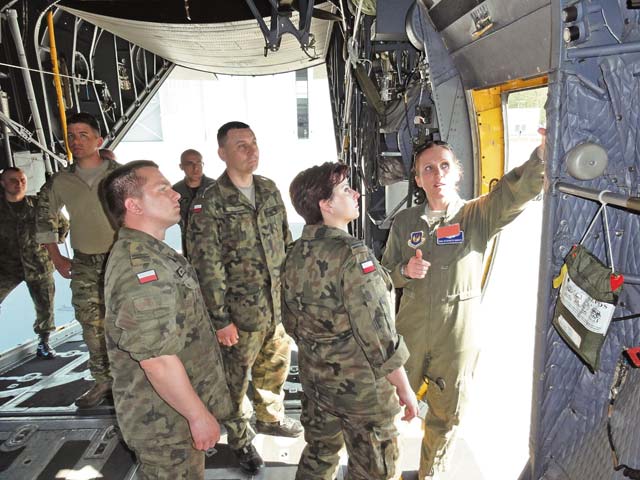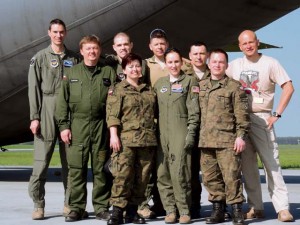
Tech. Sgt. Elizabeth Araujo, 86th Aeromedical Evacuation Squadron, discusses tactics with the Polish AE team May 9 at Plovdiv Air Base, Poland.
The 86th Aeromedical Evacuation Squadron and 435th Contingency Response Group continuously train to meet sustainable medical readiness throughout the European theater.
Training not only benefits Ramstein Airmen, but also other allies like the Polish air force who have consistently engaged in AE training and familiarization throughout 2012 and 2013.
“All NATO countries benefit from having highly skilled and qualified teams to transport wounded warriors from theater back to higher levels of medical care and eventually back to their home country,” said Lt. Col. Kevin D. Hettinger, 435th CRG flight surgeon and Poland AE Building Partnership Capacity team lead.
In early 2012, Polish AE team members visited the 86th AES Airmen on Ramstein. In turn, three months later, a member of the 86th AES attended the first medical evacuation and aeromedical evacuation conference at the Polish Air Force Academy.

Ramstein Airmen from the 86th Aeromedical Evacuation Squadron and 435th Contingency Response Group pose for a photo with the Polish AE team May 9 at Powidz Air Base, Poland.
Last month, two Airmen from the 86th AES and one Airman from the 435th CRG engaged with Poland again to focus on advancements of the Polish AE team from the previous year.
“The Polish AE team has a goal of obtaining NATO certification for aeromedical evacuation,” Hettinger said. “Our team was able to provide some recommendations toward this goal after reviewing published NATO standards for AE and inspection checklists.”
Currently, the Polish AE team can transport stabilized Polish troops from Landstuhl Regional Medical Center back to Poland.
“Their team is amazing,” said Tech. Sgt. Elizabeth Araujo, 86th Aeromedical Evacuation Squadron technician and fluent Polish speaker. “It’s a team of six. They fly as a Critical Care Air Transport Team. They do everything: they receive the phone call, they receive the plane, they set up and they fly.”
While the Polish AE team impressed their U.S. counterparts, Polish medical experts continue to work to reach their certification and sharpen their skills.
“It was nice to see how receptive they are and how willing they are to take in that information,” Araujo said. “They’re hungry for information. They want it, they’re open to suggestions, they’re willing to take criticism and learn from it.”
While the Polish AE team was absorbing information, the three Ramstein Airmen also learned from their interaction with fellow medical professionals.
“Both teams benefited as each shared their processes for safely moving patients during air evacuation,” Hettinger said.
Training between both countries is planned to continue to ensure strategic capabilities for NATO allies throughout the European theater.







